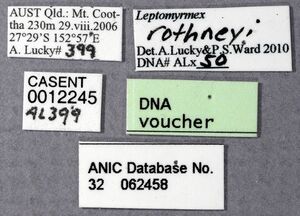Leptomyrmex rothneyi
| Leptomyrmex rothneyi | |
|---|---|

| |
| Leptomyrmex rothneyi | |
| Scientific classification | |
| Kingdom: | Animalia |
| Phylum: | Arthropoda |
| Class: | Insecta |
| Order: | Hymenoptera |
| Family: | Formicidae |
| Subfamily: | Dolichoderinae |
| Tribe: | Leptomyrmecini |
| Genus: | Leptomyrmex |
| Species: | L. rothneyi |
| Binomial name | |
| Leptomyrmex rothneyi Forel, 1902 | |
Leptomyrmex rothneyi has been recorded in rainforest, open rainforest, wet sclerophyll, dry sclerophyll and coastal sclerophylL. Nests occur in soil and in or under logs.
| At a Glance | • Replete Workers |
Identification
Leptomyrmex rothneyi bears a distinctively narrowed, dorsoventrally flattened constriction at the posterior margin of the head. This necklike structure is also present, but less exaggerated, in the closely related species Leptomyrmex ruficeps and Leptomyrmex rufipes. Coloration can help to distinguish these three: L. rothneyi has a black gaster, a pale orange mesosoma and a dark head which is a mottled brown rather than uniformly black, and often the pronotum and forecoxae are also dark and mottled. In contrast, L. ruficeps is black with a red head, and L. rufipes is pale with a black gaster. L. rothneyi can be distinguished from other Leptomyrmex based on head shape and geographic range; this species occurs only in the southeast corner of Queensland. (Lucky and Ward 2010)
Identification Keys including this Taxon
Distribution
Latitudinal Distribution Pattern
Latitudinal Range: -28.65472° to -28.65472°.
| North Temperate |
North Subtropical |
Tropical | South Subtropical |
South Temperate |
- Source: AntMaps
Distribution based on Regional Taxon Lists
Australasian Region: Australia (type locality).
Distribution based on AntMaps
Distribution based on AntWeb specimens
Check data from AntWeb
Countries Occupied
| Number of countries occupied by this species based on AntWiki Regional Taxon Lists. In general, fewer countries occupied indicates a narrower range, while more countries indicates a more widespread species. |

|
Estimated Abundance
| Relative abundance based on number of AntMaps records per species (this species within the purple bar). Fewer records (to the left) indicates a less abundant/encountered species while more records (to the right) indicates more abundant/encountered species. |

|
Biology
|
Castes
Queens have yet to be collected.
Worker
Colour variation in L. rothneyi.
           
| |
| . | |
Phylogeny
| Leptomyrmex |
| ||||||||||||||||||||||||||||||||||||||||||||||||||||||||||||||||||||||||||||||||||||||||||||||||||||||||||||||||||||||||||||||||||||||||||
Based on Barden et al., 2017. Note only selected Leptomyrmex species are included.
Nomenclature
The following information is derived from Barry Bolton's Online Catalogue of the Ants of the World.
- rothneyi. Leptomyrmex varians var. rothneyi Forel, 1902h: 473 (w.) AUSTRALIA. Lucky & Ward, 2010: 48 (m.). Subspecies of varians: Wheeler, W.M. 1934c: 102. Raised to species: Lucky & Ward, 2010: 47.
Type Material
- Syntype, 4 workers, Brisbane, Queensland, Australia, Rothney, Musee d'Histoire Naturelle Genève.
Unless otherwise noted the text for the remainder of this section is reported from the publication that includes the original description.
Description
Worker
Lucky and Ward (2010) – HL 2.32–2.45, HW 1.29–1.39, MFC 0.30–0.34, IOD 0.70–0.80, SL 4.05–4.36, EL 0.45–0.51, WL 4.30–4.56, PW 1.13–1.19, DPW 0.46–0.51, HTL 5.23–5.67, HTWmin 0.15–0.18, HTWmax 0.21–0.24, CI 0.55–0.57, SI 3.12–3.24, OI 0.13–0.14, HTC 0.64–0.86.
As in Leptomyrmex rufipes: Medium sized species head long and slender, excluding mandibles nearly twice as long as broad. Head widest just anterior to eye level. Sides of head subparallel, narrowing anteriorly, genae slightly concave. Head posterior to eyes narrowing abruptly to dorsoventrally flattened neck-like constriction, projecting posteriorly. Masticatory margin of mandible with 15 to 20 teeth and denticles interspersed. Anterior clypeal margin flat to weakly concave. Eyes positioned posterior to midline of head, relatively elongate, hairless, not surpassing margins of head. Antennae not compressed, scapes surpassing posterior margin of head by 2/3 their length.
Pronotum slender, elongate. Propodeum short, dorsal face slightly impressed tranversely at anterior end, declivitous face short and convex, angle very rounded. Petiole triangular in profile, anterior and posterior faces with median longitudinal impression, dorsum lacking an impression, posterior face longer than anterior face. Ventral surface of petiole nearly flat. Gaster elongate-elliptical. Legs very long and slender, not compressed.
Surface very finely shagreened and somewhat shining throughout. Mandibles with a coarse row of punctures along margin. Pubescence pale, sparse. Hairs minimal, confined to clypeus, venter and gaster. Body coloration dark, generally mottled brown and rufotestaceous, with antennae uniformly dark brown and antennae uniformly rufotestaceous. Femora solid dark brown, with proximal portion pale and coxae mottled dark and light. Tibiae and tarsi pale yellow. Pronotum dark brown, mottled, with the remainder of thorax rufotestaceous with variable brown mottling. Gaster solid black with terminal gastral segments yellow.
Male
Lucky and Ward (2010) – measurements (n = 4) HL 1.76–1.91, HW 1.27–1.33, SL 0.44–0.51, EL 0.65–0.73, HTL 4.49–4.89, CI 0.69–0.72, SI 0.35–0.39, SI2 0.71–0.82.
References
- Lucky, A. 2011. Molecular phylogeny and biogeography of the spider ants, genus Leptomyrmex Mayr (Hymenoptera: Formicidae). Molecular Phylogenetics and Evolution 59: 281-292. doi:10.1016/j.ympev.2011.03.004
- Lucky, A. & Ward, P.S. 2010. Taxonomic revision of the ant genus Leptomyrmex Mayr. Zootaxa 2688: 1-67. PDF
References based on Global Ant Biodiversity Informatics
- Lucky A., and P. S. Ward. 2010. Taxonomic revision of the ant genus Leptomyrmex Mayr (Hymenoptera: Formicidae). Zootaxa 2688: 1-67.
- Wheeler W. M. 1934. A second revision of the ants of the genus Leptomyrmex Mayr. Bulletin of the Museum of Comparative Zoology 77: 69-118.

